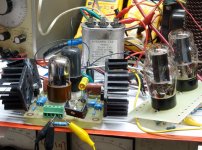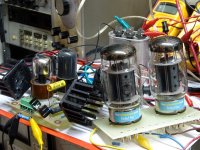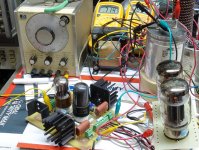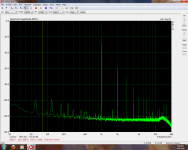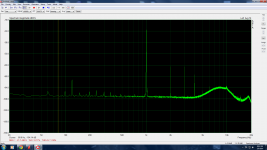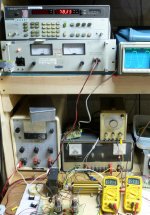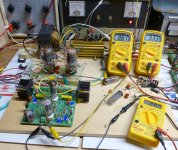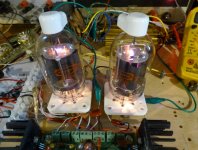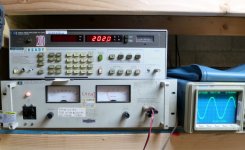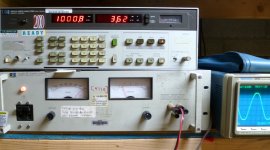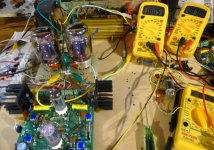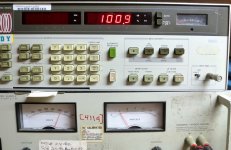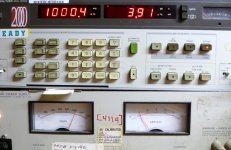2. I found that distortion, particularly h3, tends to be high for the 2d stage. You can pick at it changing tubes and operating points, but I haven't found a major cure.
A while back I took on the challenge of making an open-loop Unity-Coupled amp, just for the sheer difficulty of it. It takes huge swings to drive the output stage, so your concern #2 was big on my radar. I used CCS plate loads in the second stage and chose an absurdly linear high-impedance DHT as the tube (841) which required A2 operation as well, so I added a mosfet to drive it.
The obvious drawback to doing this is that I lost the excellent self-balance of a differential stage once I place the CCS loads on the tubes and I create potential DC stability problems, so I got rid of the CCS tail. I put a trimpot in the plate loads of the first stage to null out any imbalance in gain between the two 841s, which seems to work well. I got overall amp distortion down to 0.24% at 30W into 8 Ohms. This was second and third harmonic dominant, with slightly more second than third.
For a picture of the circuit, see here.
Anyway, that's my experience with high-swing drivers. Unfortunately, I don't have any measurements at lower drive voltages (just the one at 230Vrms in the blog). If there is interest in comparative measurements, I could take some measurements at the driver plates at lower drive levels.
I used CCS plate loads in the second stage ... so I got rid of the CCS tail.
Right. Been there, done that. Works marvelously even with fairly ordinary tubes and excellent distortion performance. But it's no longer an LTP, no matter how long the tail, just basically 2 separate VAs, with all that that implies.
But it's no longer an LTP, no matter how long the tail, just basically 2 separate VAs, with all that that implies.
Absolutely. I guess what I was trying to say is that it being 2 separate VAs implies that there can be gain mismatches between sides, and that can be easily mitigated by an AC imbalance adjustment in the first stage. In practice, I was able to get what I considered great open-loop system performance even at some pretty ridiculously-large driver swings.
If you have done both before, which approach gave better results? I don't think I could have achieved better results with a resistively loaded LTP on the 841s but maybe I am wrong.
which approach gave better results?
Undecided. I'm still studying many different approaches, which is to say I don"t have the perfect answer. I'm more interested in extracting maximum performance out of as simple circuits as possible using fairly common tubes as opposed to exotic tubes and complex circuits. Not a big fan of the AR circuits using 8-10 tubes between the PI and the finals
When you put the CCS in the plates, the circuit becomes more of a Williamson in the sense that you have a non self-balancing stage after the PI. That's OK as it works fine in a Williamson also, but I'd like to do better. I don't like having balance adjustments, but it is a simple and effective circuit.
As for keeping it all ltp: So far I've learned that I can do a 2-stage ltp into ltp driver that can deliver 35Vp with h2 well under -100dB and h3 at -70dB-ish. That's not bad for driving a normal 6L6 type PP power stage, but I'd like to do better. I've had better performance from SL7 than SN7 in the first ltp, if you can use the gain. I've also had very good results in both ltp stages from some high gm pentodes run in triode. Still working on an effective way to dc couple the stages without complex power supplies. I've also been trying for a while to do it all in one ltp stage with pentodes, but I haven't found a tube yet that can give me the gain and distortion performance at the same time.
If I had to build an amp today, I'd buy George's pcb from this thread (when it becomes available) and I can always replace CCS with resistors and vice versa as I get smarter.
I've had better performance from SL7 than SN7 in the first ltp, if you can use the gain
I found that too, but there is too much gain unless you apply GNFB. Another good input tube is the 6SU7 if you can find them. It is electrically similar to the 6SL7, but uses a different rectangular structure inside. Very low microphonics compared to some round plate 6SL7's.
Not all 6SN7's are created equal, and those fancy "red based" ones are not always the best. I have 3 or 4 old tan based tubes (Tung Sol?) that consistently provide lower distortion than my other tubes in the first stage. Again, all of these were pulled from military scrap.
I found a few pictures from the 6L6GC AB2 design days.
The 9 pin boards allow for more flexibility with tubes. I have had good luck with some 5751's in the first stage.
I've also been trying for a while to do it all in one ltp stage with pentodes, but I haven't found a tube yet that can give me the gain and distortion performance at the same time.
The jury is still out on this yet. You need to feed the pentode enough current to get the Gm up, which means a lower value plate load resistor, and you need a higher resistor value to get more gain for a given Gm. So you crank up the plate supply voltage......
Gary Pimm proved that excellent results can be had with certain pentodes and a CCS, or partial CCS (resistor across it) load. I have been experimenting with various bootstrapping circuits to make the effective load look higher. This looks like a valid strategy. I made an input stage for a guitar amp that would run at a gain of nearly 400 with a common 6AU6 type tube. No attempt was made to optimize, or even measure single stage distortion.
I'm currently experimenting with a CCS in the tail with a bootstrap constant voltage plate load. Too soon to tell if it will work though.
I'd buy George's pcb from this thread (when it becomes available)
I have plenty of boards, just no time to write up the assembly instructions, or place to take the pictures, yet.
Attachments
I'm more interested in extracting maximum performance out of as simple circuits as possible using fairly common tubes as opposed to exotic tubes and complex circuits. Not a big fan of the AR circuits using 8-10 tubes between the PI and the finals
There's something to be said for a simple circuit that works well. I doomed myself to some complexity when I decided to do the Unity-Coupled amp, though. The drive requirements are just not easy to satisfy.
Of course, we are talking apples and oranges when comparing approaches since 35Vp won't even drive my output stage (essentially a mu=2 arrangement) to even moderate listening levels. I started with CCS-loaded 6SN7s and found them to be much inferior to the 841s to develop the 200Vrms that I needed to drive the output stage to clipping. You can see the difference below. The 841s really are a nice tube, too bad they require grid current are almost impossible to get.
I'd like to someday do a cathode-follower SE amp some day. My next experiment will be a CCS-loaded EL34 with plate-grid feedback. I think that the high transconductance of the EL34 will make a driver that can swing 800Vpk-pk+ with low distortion, and EL34 are easy to buy and fairly inexpensive.
ETA: The first graphic is CCS-loaded 6SN7 @ 200Vrms, second is 841 @ 230Vrms.
Attachments
Last edited:
I have put the breadboard back together, wired for common octal audio tubes. The driver feeding into the 8903A audio analyzer with no output tubes installed reads 0.14% distortion at 30 V RMS output. More testing is coming......I can smell the aroma of glowing tubes.
Last edited:
I have put the breadboard back together, wired for common octal audio tubes. The driver feeding into the 8903A audio analyzer with no output tubes installed reads 0.14% distortion at 30 V RMS output. More testing is coming......I can smell the aroma of glowing tubes.
I think I can speak for all your fans George...we have been anxiously awaiting this moment...
I plugged in my crispy old set of Chinese "6L6GC's" wired in pentode mode. These tubes came to me in a Fender Bandmaster. A friend asked me to put some new Russian tubes in his amp, he had grown tire of the Chinese "Ruby Tubes" that were in there. I did so, and decided that the Rubys would be used for "testing." These are the same tubes seen in post #127 making 75 watts with 500 volts on them, so I set the amp up under the same test conditions, and let it rip. They still put out 75 watts at 1.8% THD, and still hit clipping around 95 watts. 3300 ohm load 500 volts B+, 400 volts G2, idle current 50 mA.
I then wired them as triodes, 500 volts B+, 3300 ohm load, 50mA idle, and cranked the drive until I got severe clipping.....watt meter reads 78 watts. OK, it's alive....
I was asked about 385 volts in triode, so I went there. I have a 6600 ohm OPT that works well at 3300 ohms, so I tested at these two impedances. No feedback was used. I'm guessing the best spot is somewhere between these impedances. THD at various power levels:
Power THD @ 3300 ohm load THD @ 6600 ohm load
1W 0.177% 0.183%
10W 0.91% 0.90%
20W 1.63% 1.69%
30W 2.73% 4.41%
35W 3.70% 10.86%
40W 5.42% severe clipping
Now it's time to toast some sweep tubes.
I then wired them as triodes, 500 volts B+, 3300 ohm load, 50mA idle, and cranked the drive until I got severe clipping.....watt meter reads 78 watts. OK, it's alive....
I was asked about 385 volts in triode, so I went there. I have a 6600 ohm OPT that works well at 3300 ohms, so I tested at these two impedances. No feedback was used. I'm guessing the best spot is somewhere between these impedances. THD at various power levels:
Power THD @ 3300 ohm load THD @ 6600 ohm load
1W 0.177% 0.183%
10W 0.91% 0.90%
20W 1.63% 1.69%
30W 2.73% 4.41%
35W 3.70% 10.86%
40W 5.42% severe clipping
Now it's time to toast some sweep tubes.
Attachments
decent performance for a driver, especially with 6SN7/6CG7.
Those are the same tubes that I pulled out of the driver board that I started out with when I got involved with this thread. If I remember right, I went through a big box full of used tubes and picked some with low distortion in LTP.
I'd be curious if h3 is dominant.
I would bet that H3 is the dominant harmonic, there should be very little H2. I have not set my FFT PC up yet. Still need a few bits that are in a box somewhere. I have moved twice since I last had my lab set up. Can't find squat. I'm still missing two power supplies.
that triode-strapped high gm pentodes are your best bet for the second stage ltp.
I have been working that route too. I have another driver board that uses a pair of triode / pentode tubes. The triode section is the first stage LTP, and the second stage can be wired as a triode, or true pentode in LTP. Some of these tubes have a pentode Gm of over 20000.
More testing is coming......I can smell the aroma of glowing tubes. Having said that, there is only one thing left to do........test some tubes. All testing was done with a 3300 ohm load, no feedback was used.
I plugged in a pair of 6BQ6GA sweep tubes. They have the same pinout as the 6L6GC except there is a plate cap, wire it to pin 3.....Do not try this unless you know what you are doing. These are NOT compatible tubes unless the amp is designed to deal with tubes having really different characteristics. The 6BQ6GA's cranked out 100 watts without complaint on 500 volts. Screen voltage was 190, idle current 50 mA.
1W 0.115%
5W 0.150%
10W 0.334%
20W 1.152%
30W 2.033%
50W 3.27%
75W 3.99%
100W 3.41%
I had a pair of unmarked tubes. It took 25 volts on the heater to make them light up, and they looked like 50L6's, so I am assuming that's what they are. I decided to see how far they would go before turning into red light bulbs.......40 watts brought some pale glow in a dark room and 44 watts brought clipping. More plate voltage invited runaway, and a bright red glow. Yes, I bent the plate voltage spec a wee bit......400 volts! 120V on the screen. These tubes seemed OK at 400 volts and 40 watts for about 10 minutes.
I tried a pair of 6Y6GA's with about the same results, 40 watts on 400 volts.
20+ years ago I bought a factory sealed bulk pack box of 100 Sylvania 6V6GTA's at a NASA surplus auction along with a bunch more tubes. The 6V6's obviously had some kind of manufacturing problem since half the getters were white or gone when I opened the box. Most of the remaining tubes have gone gassy since then. I have maybe 20 left, but I will not trust them in anything critical, so time to see how much you can squeeze out of a 6V6GTA....
I picked a pair of tubes that didn't exhibit any weird effects until I got over 400 volts on the plate. Those tubes cranked out some of the lowest distortion numbers I have seen, but those numbers kept rising as I abused them. Something is making these tubes gassy. They either have an air leak or some internal contamination. Upon power up, setting bias and cranking the power out to 25 watts on 370 volts, the distortion read 0.82%. After glowing a couple times, it was 1.8 % at the same settings. Data on the tubes after beating on them for a half hour or so. 3300 ohm load, 300 volts screen, 410 volts plate, 30 mA idle current.
0.5W 0.26%
1.0W 0.633%
2.0W 0.741%
5.0W 0.903%
10W 1.44%
20W 1.73%
30W 1.97% faint glow on one plate in a totally dark room
40W 1.77% pale glow, can't see it in dim light.
50W 2.47% faint glow, not as bad as 40W, brighter than 30W
OK time for some bigger tubes......I had about 50 bulk pack Chinese KT88's when I was building guitar amps 20 years ago. They blew up a lot....so bad that one actually shattered when operated within the ratings. I still have 5 of them that have withstood the test of time and my abuse over 20 years, so time to test them again. I plugged them in and cranked them up. 100 watts on 525 volts, no glow, no bang.
Let's see what else can I test.......how about some tubes out of a Collins radio transmitter????? 4D32's.
What can they do......202 watts on 650 volts. That's the limit on my power supply. The load resistor is only good for 125 watts, and the OPT is only rated for 80 watts in guitar amp duty.....I haven't blown anything up, or set anything on fire yet, so, for now, I'm going to quit while I'm ahead.
I plugged in a pair of 6BQ6GA sweep tubes. They have the same pinout as the 6L6GC except there is a plate cap, wire it to pin 3.....Do not try this unless you know what you are doing. These are NOT compatible tubes unless the amp is designed to deal with tubes having really different characteristics. The 6BQ6GA's cranked out 100 watts without complaint on 500 volts. Screen voltage was 190, idle current 50 mA.
1W 0.115%
5W 0.150%
10W 0.334%
20W 1.152%
30W 2.033%
50W 3.27%
75W 3.99%
100W 3.41%
I had a pair of unmarked tubes. It took 25 volts on the heater to make them light up, and they looked like 50L6's, so I am assuming that's what they are. I decided to see how far they would go before turning into red light bulbs.......40 watts brought some pale glow in a dark room and 44 watts brought clipping. More plate voltage invited runaway, and a bright red glow. Yes, I bent the plate voltage spec a wee bit......400 volts! 120V on the screen. These tubes seemed OK at 400 volts and 40 watts for about 10 minutes.
I tried a pair of 6Y6GA's with about the same results, 40 watts on 400 volts.
20+ years ago I bought a factory sealed bulk pack box of 100 Sylvania 6V6GTA's at a NASA surplus auction along with a bunch more tubes. The 6V6's obviously had some kind of manufacturing problem since half the getters were white or gone when I opened the box. Most of the remaining tubes have gone gassy since then. I have maybe 20 left, but I will not trust them in anything critical, so time to see how much you can squeeze out of a 6V6GTA....
I picked a pair of tubes that didn't exhibit any weird effects until I got over 400 volts on the plate. Those tubes cranked out some of the lowest distortion numbers I have seen, but those numbers kept rising as I abused them. Something is making these tubes gassy. They either have an air leak or some internal contamination. Upon power up, setting bias and cranking the power out to 25 watts on 370 volts, the distortion read 0.82%. After glowing a couple times, it was 1.8 % at the same settings. Data on the tubes after beating on them for a half hour or so. 3300 ohm load, 300 volts screen, 410 volts plate, 30 mA idle current.
0.5W 0.26%
1.0W 0.633%
2.0W 0.741%
5.0W 0.903%
10W 1.44%
20W 1.73%
30W 1.97% faint glow on one plate in a totally dark room
40W 1.77% pale glow, can't see it in dim light.
50W 2.47% faint glow, not as bad as 40W, brighter than 30W
OK time for some bigger tubes......I had about 50 bulk pack Chinese KT88's when I was building guitar amps 20 years ago. They blew up a lot....so bad that one actually shattered when operated within the ratings. I still have 5 of them that have withstood the test of time and my abuse over 20 years, so time to test them again. I plugged them in and cranked them up. 100 watts on 525 volts, no glow, no bang.
Let's see what else can I test.......how about some tubes out of a Collins radio transmitter????? 4D32's.
What can they do......202 watts on 650 volts. That's the limit on my power supply. The load resistor is only good for 125 watts, and the OPT is only rated for 80 watts in guitar amp duty.....I haven't blown anything up, or set anything on fire yet, so, for now, I'm going to quit while I'm ahead.
Attachments
1625's Transformer driven?
Hi All, I've got dozens of these nice, NOS Sylvania 1625's from 1944. I'd like to do something Class AB2 so I can avoid the hard clipping of run-o-the-mill Williamson type driver circuits. While I see great results here with mosfet drive, Has anyone done a transformer coupled drive with 6BX7's or 6AS7's pushing a little power into the grid? I'd like to avoid using the three legged fuses.
Hi All, I've got dozens of these nice, NOS Sylvania 1625's from 1944. I'd like to do something Class AB2 so I can avoid the hard clipping of run-o-the-mill Williamson type driver circuits. While I see great results here with mosfet drive, Has anyone done a transformer coupled drive with 6BX7's or 6AS7's pushing a little power into the grid? I'd like to avoid using the three legged fuses.
Hi All, I've got dozens of these nice, NOS Sylvania 1625's from 1944. I'd like to do something Class AB2 so I can avoid the hard clipping of run-o-the-mill Williamson type driver circuits. While I see great results here with mosfet drive, Has anyone done a transformer coupled drive with 6BX7's or 6AS7's pushing a little power into the grid? I'd like to avoid using the three legged fuses.
How so you intend to use the 1625s? If you're using them as 'AB2 pents, then there is no need for IST coupling. You could use the 6BX7s as cathode follower grid drivers. 'AB2 1625s aren't a tough load, and a stiff power follower (the 6BX7 was originally intended for service as a vertical deflection oscillator/power amp for B & W TV sets). I used 807s in one project,and I'm getting 32W @ 1.0KHz even though specced at 26.5W since the 6SN7 cathode followers can take 'em just a bit into 'AB2 for a few extra watts.
Power triodes require stiffer drive since there's just the one grid to pull current when Vgk > 0. For that, PP 6BX7s driving the grids through an IST would be a good idea if you're not including gNFB.
Let's see what else can I test.......how about some tubes out of a Collins radio transmitter????? 4D32's.
What can they do......202 watts on 650 volts. That's the limit on my power supply. The load resistor is only good for 125 watts, and the OPT is only rated for 80 watts in guitar amp duty.....I haven't blown anything up, or set anything on fire yet, so, for now, I'm going to quit while I'm ahead.
Attached Thumbnails
yummy.....thanks George, you made my day...
btw, what was your OPT primary at?
How so you intend to use the 1625s? If you're using them as 'AB2 pents, then there is no need for IST coupling. You could use the 6BX7s as cathode follower grid drivers. 'AB2 1625s aren't a tough load, and a stiff power follower (the 6BX7 was originally intended for service as a vertical deflection oscillator/power amp for B & W TV sets). I used 807s in one project,and I'm getting 32W @ 1.0KHz even though specced at 26.5W since the 6SN7 cathode followers can take 'em just a bit into 'AB2 for a few extra watts.
Power triodes require stiffer drive since there's just the one grid to pull current when Vgk > 0. For that, PP 6BX7s driving the grids through an IST would be a good idea if you're not including gNFB.
Miles, you probably will hate me for this, but have you tried mosfet followers as grid drivers?
Miles, you probably will hate me for this, but have you tried mosfet followers as grid drivers?
O have a project in the works that will use them. That does use a power triode. So far, one design used 807s as pentodes, the other 6BQ6s (TV HD power finals). Pents aren't hard loads, and even modest cathode followers are up to the task of driving the grids.
- Status
- This old topic is closed. If you want to reopen this topic, contact a moderator using the "Report Post" button.
- Home
- Amplifiers
- Tubes / Valves
- 6L6GC AB2 Amp
